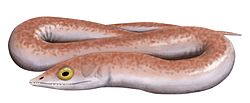| Osteolepididae Temporal range: Devonian | |
|---|---|
 | |
| Life restoration of Osteolepis | |
| Scientific classification | |
| Kingdom: | Animalia |
| Phylum: | Chordata |
| Class: | † Osteolepidida |
| Order: | † Osteolepiformes |
| Family: | † Osteolepididae Cope, 1889 |
| Genera | |
See text | |
Osteolepididae is a family of primitive, fish-like tetrapodomorphs (the clade that contains modern tetrapods and their extinct relatives) that lived during the Devonian period. The family is generally thought to be paraphyletic, with the traits that characterise the family being widely distributed among basal tetrapodomorphs and other osteichthyans. [1] Some of the genera historically placed in Osteolepididae have more recently been assigned to the family Megalichthyidae, which appears to be a monophyletic group. [2]





